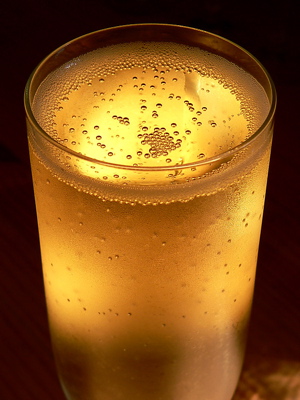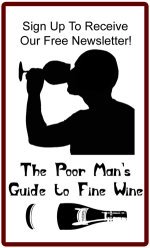|
|
Wine Temperature for Serving
 What is the perfect wine temperature for serving? Well that all depends on the type of wine. However, most wine neophytes don't pay much attention to service temperature at wine tastings or dinners and it can have a dramatic impact on the presentation of the wine. While a wine at the ideal temperature can show beautifully, the same wine at too high a temperature or too low a temperature can seem unbalanced, hesitant or even appear to have off aromas and flavors. We encourage to pay some attention to wine temperature when learning how to serve wine to your guests. What is the perfect wine temperature for serving? Well that all depends on the type of wine. However, most wine neophytes don't pay much attention to service temperature at wine tastings or dinners and it can have a dramatic impact on the presentation of the wine. While a wine at the ideal temperature can show beautifully, the same wine at too high a temperature or too low a temperature can seem unbalanced, hesitant or even appear to have off aromas and flavors. We encourage to pay some attention to wine temperature when learning how to serve wine to your guests.
If you are looking for information about wine storage temperature, see our Wine Storage page for information about wine cellars and storing wine.
- What effect can the wrong wine temperature have?
Many of the components of a wine's aroma and flavor are very temperature dependent. For example, alcohol is a volatile substance which is very temperature sensitive. Higher wine temperature accentuates alcohol aroma and flavor and lower temperature tends to hide it. Likewise, many aromatic compounds in wine are more prevalent and noticeable at higher temperatures because they are volatilized more and are hidden at lower temperatures. Ideally, you want a wine at a temperature where all these components are balanced so that none are too dominant or obtrusive. At higher temperatures the wine can seem "hot" exhibiting too much alcohol which obscures the other aromas while at too low a temperature the aromas may be hidden and hard to distinguish. A happy medium is the goal which varies for different types of wines. - How do you control the wine temperature when you are serving?
Most people, even those that are really picky about correct wine temperature, do not take specific temperature readings of their wines. While you are welcome to dip a clean thermometer into your open bottle to get an exact reading, this would be impractical for most situations. While a strip thermometer can be held against the side of the wine bottle or decanter, this may be misleading because if the bottle was recently in the refrigerator or an ice bucket the outside may be cooler than the wine within. More importantly, having a sense for what temperature the wine was to begin with will help you determine the right time to serve the wine. The three main ways we can get an initial temperature for a bottle of wine is a wine cellar, a refrigerator and a Champagne bucket or other wine chilling ice bucket. By knowing the temperature of these areas, you can estimate the starting temperature of your bottle.On the other hand, if you are not in control of the wine service, for example if you are served a wine at a tasting or dinner which is not at the correct wine temperature, there are a few things you can do. If the wine is served too cold and you are having a hard time smelling the aromatics, hold the bowl of your glass in your hand and swirl the wine around. The warmth of your hand will help warm up the wine faster than just sitting at room temperature. On the other hand, if you are served a wine which is too warm it may be harder to remedy. If you are in a restaurant, ask your server for an ice bucket to chill the rest of the bottle. If you are at a wine tasting, it may be harder to do this in a discrete way that won't insult your host. Maybe suggest to your host that the remainder of the bottle be chilled a bit if you feel comfortable doing so. - What is ice bucket temperature, refrigerator temperature and cellar temperature?
Most refrigerators have a temperature of about 35 - 38° F (1.7 - 3.3° C). This means that wines which have sat long enough to equilibrate in the refrigerator will be this temperature when first removed. This is too cool to serve wine immediately for any type of wine! Any wine straight out of the fridge will not show many aromatics and will seem simple and close up. An ice bucket with plenty of ice and some water such as a Champagne bucket is even colder at close to 32° F (0° C). Not everyone has a wine cellar, but a standard wine cellar keeps wine at a stable 55° F (13° C).
General Wine Temperature Guidelines for Various Types of Wines- Red Wines
Red wines generally show best at slightly higher temperatures but not as high as you may think! Generally, room temperature (around 70° F, but this can vary somewhat depending on the climate and air conditioning or heating) is generally too warm for most wines! So even red wines can benefit from a bit of chilling. Generally, full-bodied red wines like Bordeaux, Cabernet Sauvignon, Rhone wines and others show best at just under room temperature in the 60 to 65° F range. In general, the more powerful, full-bodied wines are better at the upper end of the range while slightly lighter wines (Pinot Noir, red Burgundy, Chianti, etc.) are better at the lower end of the range. Very light-bodied, fruity wines (Beaujolais, lighter Pinot Noirs, etc.) can even benefit for more of a chill down to the mid-50°'s F. These are very general guidelines of course as each wine is different and any one type of wine can vary quite considerably. For example, there are versions of Pinot Noir that are quite full-bodied and others that are very light and might benefit from lower temperatures.To achieve these temperatures you have a few options. If you have a wine cellar at 55° F, removing the wine from the cellar and letting sit for a few minutes before serving will allow it to move up into the upper 50's to low 60's. The wine will continue to warm up towards room temperature after pouring in the glass. Another option is to chill the room temperature bottle in the refrigerator or an ice bath for only a few minutes. If you leave it too long it will be too cold to serve, but a few minutes helps to bring down the temperature a few degrees below room temperature. - White Wines
In general, white wines show better at slightly lower temperatures. Again, this varies by type and weight of wine. Full bodied white wines like some Chardonnay, white Burgundies and Savennieres can show well at higher temperatures in the low 60°'s F or down to as low as around 48° F. Lighter, fruitier grapes like dry or off-dry Rieslings and Sauvingnon Blanc show better at the lower end of this range down to the mid-40°'s F. These temperatures can be achieved quickly with a bit longer time in the refrigerator or in an ice bucket. Again, once opened and poured, the wine will continue to warm up in the glass. The bottle can be kept cool by keeping it in an ice bucket periodically to keep it at ideal wine temperature. - Sparkling Wines
Typically, sparkling wines are served at quite low temperatures, around 45° F. This helps to keep the flavors focused and prevents overly aggressive bubbling from the carbonation. These can be kept in the refrigerator or in a Champagne bucket. Because the pours and glasses tend to be smaller, they will warm up to the proper range quite quickly from that starting point. - Dessert (Sweet) Wines
Dessert wines with some sweetness are hard to generalize because of the wide range in styles. Heavy, sweet red wines like Vintage Port tend to do well closer to room temperature around 66° F. Lighter ports like Tawny or Non-Vintage ports can show well a bit cooler, in the upper-50's. White sweet wines like Sauternes and sweet Rieslings show well cooler still in the low-50° range. Simple, sweet sparklers like Moscato d'Asti and some Champagne Demi-Secs do well at quite cool wine temperature in the low-40° range.
So in conclusion remember that room temperature is almost always too warm to serve any type of wine (unless your air conditioner is set quite low!). Chill even red wines down a bit and you'll notice them come into more focus and balance, heightening your wine tasting experience. Likewise, refrigerator temperature is quite low for most wines. If your wine has been chilling in the refrigerator for some time, open it early so it has a chance to come up a few degrees before serving. Cheers!
Done learning about serving at the correct Wine Temperature?
Return to the How to Serve Wine page.

|
|
|




 What is the perfect wine temperature for serving? Well that all depends on the type of wine. However, most wine neophytes don't pay much attention to service temperature at wine tastings or dinners and it can have a dramatic impact on the presentation of the wine. While a wine at the ideal temperature can show beautifully, the same wine at too high a temperature or too low a temperature can seem unbalanced, hesitant or even appear to have off aromas and flavors. We encourage to pay some attention to wine temperature when learning how to serve wine to your guests.
What is the perfect wine temperature for serving? Well that all depends on the type of wine. However, most wine neophytes don't pay much attention to service temperature at wine tastings or dinners and it can have a dramatic impact on the presentation of the wine. While a wine at the ideal temperature can show beautifully, the same wine at too high a temperature or too low a temperature can seem unbalanced, hesitant or even appear to have off aromas and flavors. We encourage to pay some attention to wine temperature when learning how to serve wine to your guests.


